
Samuel Franklin Cowdery was a Wild West showman and early pioneer of manned flight. He is most famous for his work on the large kites known as Cody War-Kites, that were used by the British before World War I as a smaller alternative to balloons for artillery spotting. He was also the first man to fly an aeroplane built in Britain, on 16 October 1908. A flamboyant showman, he was often confused with Buffalo Bill Cody, whose surname he took when young.
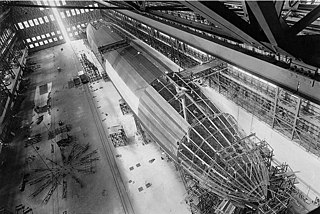
A rigid airship is a type of airship in which the envelope is supported by an internal framework rather than by being kept in shape by the pressure of the lifting gas within the envelope, as in blimps and semi-rigid airships. Rigid airships are often commonly called Zeppelins, though this technically refers only to airships built by the Luftschiffbau Zeppelin company.

The 23 class were rigid airships produced in the United Kingdom during the First World War. Development of the 23 class began in August 1915 when Vickers was asked to improve the 9r design by increasing its gas capacity by adding a bay and increasing the capacity of the bow and stern gas cells. The 23-class was designed by H.B. Pratt and Barnes Wallis of Vickers. Vickers built the first and last of the four ships. The other two were built by William Beardmore and Company and Armstrong-Whitworth. While the 23 class airships were never used in combat, the four ships provided many hours of valuable training and experimental data for British airship crews and designers. Although a total of 17 of these ships were contemplated at one time, only four were ever built. The 23 class was found to be significantly overweight, leading to its cancellation in favour of the more-refined R23X class.
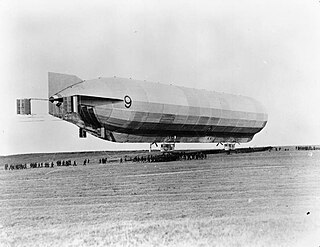
HMA No. 9r was a rigid airship designed and built by Vickers at Walney Island just off Barrow-in-Furness, Cumbria. It was ordered in 1913 but did not fly until 27 November 1916 when it became the first British rigid airship to do so. It was dismantled in June 1918 after being flown for around 165 hours, mainly for experimental purposes.

The Santos-Dumont No. 6 was an airship designed and built by the Brazilian pioneer aviator Alberto Santos-Dumont. In 1901 it was used by him to win the Deutsch de la Meurthe prize for a flight from Parc Saint Cloud to the Eiffel Tower and back within thirty minutes.
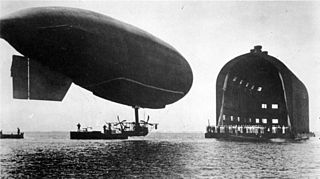
The DN-1 was the US Navy's first airship. Captain Mark L. Bristol, the second Director of Naval Aviation, supported the development of the dirigible in the anti-submarine role. Victor Herbster, Holden Richardson and LCDR Frank McCrary drew up the specifications for the DN-1. The contract was awarded on 1 June 1915 to the Connecticut Aircraft Company of New Haven, CT. The U.S. Navy had no experience with airships and it seems neither had any of the principals of Connecticut Aircraft Company. They were a lawyer who was the financial backer, an amusement park owner who acted as manager; the technical staff was an Austrian, Hans Otto Stagel, who claimed to be a dirigible pilot and a German engineer and mechanic, who claimed to be Zeppelin experts. Jerome Clarke Hunsaker of MIT and his assistant Donald Wills Douglas, later founder of the Douglas Aircraft Company, aided the Connecticut Aircraft Company in the design of DN-1. The Chief Engineer was James F. Boyle and the Production Manager was J.J. DeLunay. The civilian inspector was Thomas Scott Baldwin and the resident Navy inspector was Frank M. McCrary.

The British Army Aeroplane No 1 or sometimes Cody 1 was a biplane built by Samuel Franklin Cody in 1907 at the Army Balloon Factory at Farnborough. It made the first recognised powered and sustained flight in the United Kingdom on 16 October 1908.

British Army Dirigible No 1, christened Nulli Secundus was a Semi-rigid airship. First flown on 10 September 1907, it was Britain's first powered military aircraft.

The Clément-Bayard No.1, Bayard-Clément was a French military semi-rigid airship of 1908 developed by Astra Clément-Bayard, which was founded by industrial entrepreneur Adolphe Clément-Bayard, in response to a French Army decision to experiment with airship operations. Société Astra was contracted to build the envelope, while Clément-Bayard built the gondola and engines itself. The envelope's distinctive design featured four large lobes at the aft end, intended to provide directional stability. Testing commenced on 29 October with Henry Kapferer at the controls. By the end of the year, the airship had made nearly thirty flights, including long-range cross-country sorties of up to 200 km (120 mi), breaking the national aerial endurance and speed records.

The Coastal Class were a class of non-rigid airship or "blimp" used by the Royal Naval Air Service (RNAS) during World War I. The C-class blimp operated by the United States Navy after the war was a completely unrelated design. In total 35 Coastals were built, all at RNAS Kingsnorth, Kent. Entering service in 1916, the Coastal class remained in widespread service until 1918, with a few members of the class still in service at the signing of the Armistice, while others were replaced by the improved C-Star class as they became unfit for service. The blimps were used for long anti-submarine patrols in the Western Approaches and English Channel, protecting convoys from German U-boats. The Coastal class was one of the first aircraft types specifically designed to detect and attack submarines.

The Willows airships were a series of pioneering non-rigid airships designed and built in Wales by Ernest Thompson Willows in the first decade of the 20th century. The first airship Willows No. 1 flew in 1905, and the last, the Willows No. 5 in 1913.
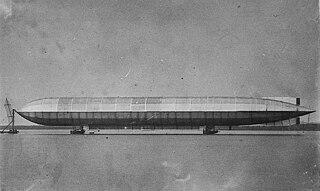
His Majesty's Airship No. 1 was designed and built by Vickers, Sons and Maxim at their works in Barrow-in-Furness, Lancashire, England, as an aerial scout airship for the Royal Navy. It was the first British rigid airship to be built, and was constructed in a direct attempt to compete with the German airship programme. Often referred to as "Mayfly", a nickname given to it by the lower deck, in public records it is designated ‘HMA Hermione’ because the naval contingent at Barrow were attached to HMS Hermione, a cruiser moored locally preparing to act as its tender.

SSclass airships were simple, cheap and easily assembled small non-rigid airships or "blimps" that were developed as a matter of some urgency to counter the German U-boat threat to British shipping during World War I. A secondary purpose was to detect and destroy mines. The class proved to be versatile and effective, with a total of 158 being built in several versions.

The Lebaudy République was a semi-rigid airship built for the French army in Moisson, France, by sugar manufacturers Lebaudy Frères. She was a sister ship of the Patrie, the main differences between the two being in the dimensions of the gasbag and the ballonet. Although she was operationally successful, the République crashed in 1909 due to a mechanical failure, killing all four crew members.
Neville Usborne was a British naval officer who played a prominent part in British military lighter-than-air aviation before the First World War. He was involved with the construction of the first British rigid airship HMA No. 1 and was killed in one of the first experiments in launching an aeroplane from an airship.
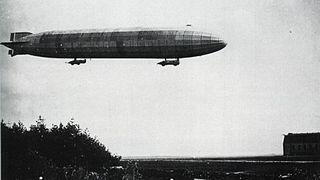
The Zeppelin P Class was the first Zeppelin airship type to be produced in quantity after the outbreak of the First World War. 22 of the type were built as well as 12 of a lengthened version, the Q Class . They were used for many of the airship bombing raids on the United Kingdom in 1915-16, for naval patrol work over the North Sea and Baltic and were also deployed on the eastern and south-eastern fronts.

The pioneer era of aviation was the period of aviation history between the first successful powered flight, generally accepted to have been made by the Wright Brothers on 17 December 1903, and the outbreak of the First World War in August 1914.

The Lebaudy Morning Post was a French semi-rigid airship built for the British Army in Moisson, France, by manufacturers Lebaudy Frères. The airship was commissioned by the newspaper The Morning Post, who created a fund to purchase the airship and present it to the British Army. The airship's envelope was damaged on the delivery flight and then it was destroyed on a subsequent trial flight after repair. At the time of construction it was the largest airship that had been built in France.



















